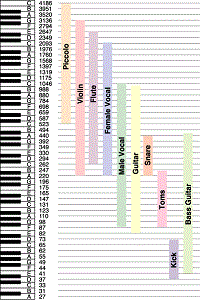Tips for Vocal EQ
Below is a good article on vocal EQ (equalizer) tips. Whether you’re a voice-over person or you also record music, chances are good you’ll want to know a little something about vocal EQ (remember that EQ is short for equalization, which is one of the audio recording terms that don’t really describe what it means to the layman…sigh).
If you want to brush up on what it is all about, check out our article here: What is Equalization, Usually Called EQ? or Good Equalization and Frequency Basics.

Anyway, the human voice tends to live in a very predictable place on the frequency spectrum. See the picture to the left, which should help describe this. Male and female voices overlap between 300 and 900 “hertz” (cycles-per-second or “HZ”).
In an ideal world, or more specifically, and ideal recording situation, you would not need to EQ the human voice at all. When doing voice-over work, I rarely use EQ (except to fix p-pops – see our article: www.homebrewaudio.com/how-to-fix-a-p-pop-in-your-audio-with-sound-editing-software). But we don’t live in a perfect world and few of us have that ideal recording set-up (great recording space, top-drawer gear, etc. so there are times when applying EQ to a vocal track is desirable or necessary.
One other thing I often use and EQ effect for is to filter out mouth clicks, those saliva sounds that cause those clicky sounds. In fact I have an article on THAT too: How To Use An Audio Editor To Remove Saliva Noises From Voice Recordings.
Dev’s article explains those situations and gives you some ideas on how to deal with them using EQ.
Read his article here: https://www.hometracked.com/2008/02/07/vocal-eq-tips/
